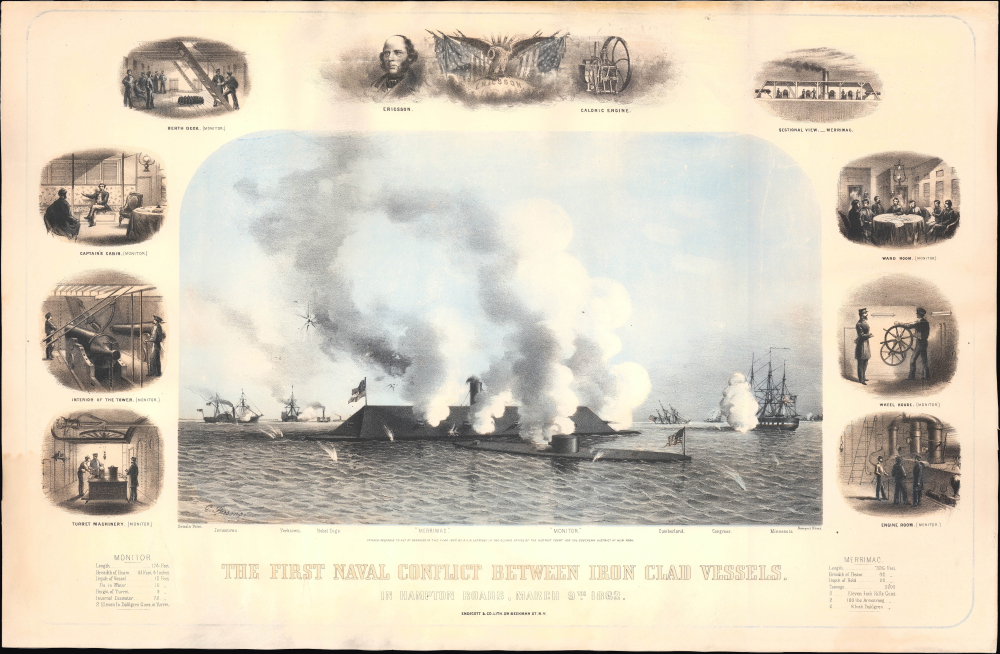1862 Endicott View of the Battle between the Ironclads Monitor and Merrimac
MonitorMerrimac-endicott-1862
Title
1862 (dated) 13.5 x 21 in (34.29 x 53.34 cm)
Description
A Closer Look
This view depicts the legendary confrontation between the Monitor and the Merrimac (originally spelled 'Merrimack' with a k), the first battle in history between ironclad warships. Perspective is oriented towards the west, with Newport News at right and Sewals Point at left, as indicated by the labels under the view ('Jamestown' and 'Yorktown' here refer to the names of Confederate ships, not the nearby cities by those names). The Monitor and Merrimac (or Virginia) dominate the view at center, while other Union and Confederate ships appear nearby. Surrounding the view are vignettes of the interior of the ships, mostly the Monitor, as well as a portrait of its designer, Swedish-born engineer John Ericsson (1803 - 1889). At bottom-left and right are dimensions and other details about both ships. This view was among the first depictions of the famous naval battle disseminated to the public, along with similar views by Henry Bill and Currier and Ives (both previously sold by us), leaving a deep impression on the popular perception of the battle and the war overall.Battle of the Ironclads
The Battle of the Monitor and Merrimac, part of the wider Battle of Hampton Roads, stands as a pivotal moment in naval history, occurring over two days on March 8-9, 1862, during the American Civil War. At Hampton Roads, Virginia, the Confederate Navy sought to challenge the Union blockade that was stifling the Southern economy and its ability to sustain the war. The Confederates repurposed the scuttled USS Merrimac, armoring it with iron and renaming it the CSS Virginia. When the Union side heard of the Confederate modifications to the Merrimac, Ericson, who had for several years worked on designs for an ironclad ship with a rotating turret, was tasked with preparing an equivalent vessel. The need for a Union ironclad was demonstrated when the Virginia obliterated two wooden Union warships, the USS Cumberland and the USS Congress, in the opening phase of the Battle of Hampton Roads.The carnage might have continued if not for the timely arrival of the USS Monitor, a revolutionary Union ironclad with a rotating turret. On the second day, the two iron giants clashed, firing heavy shells at point-blank range but failing to inflict critical damage on one another. While neither side could claim a definitive victory, the engagement proved the concept of the 'ironclad', transforming naval combat thereafter. The supremacy of ironclad warships was clear, rendering wooden navies obsolete and ushering in a new era of naval warfare characterized by armored vessels and heavy artillery.
Publication History and Census
This view (and presumably the surrounding vignettes) was drawn by Charles Parsons and printed by Endicott and Co. in New York in 1862, with a copyright held by S.C.A. Lotridge. It is noted among the holdings of the Boston Athenaeum, Williams College, and the American Antiquarian Society in the OCLC. It also appears in the institutional collections of the Yale University Art Gallery, the National Portrait Gallery (Smithsonian Institution), the Historical Society of Philadelphia, and the Hood Museum of Art at Dartmouth College.CartographerS
Charles Parsons (1821 - November 9, 1910) was an American artist and lithographer active in New York. Parsons was born in Hampshire, England in 1821. He emigrated to the united States at 9, apprenticing as a lithographer under George Endicott from 1833. Parsons produced numerous views and lithographs for Endicott and Company, but also engraved or Nathaniel Currier, later Currier and Ives. In 1863 he became the art director for Harper’s Publishing, a position he held until 1889, when he retired. Parson's was influential in the development of American illustration and lithography. His son, Charles R. Parsons, was also an artist based first in Manhattan, then Brooklyn. More by this mapmaker...
Endicott and Company (fl. c. 1828 - 1891) was a New York based family run lithography firm that flourished throughout the 19th century. The firm was founded by George and William Endicott, brothers who were born in Canton, Massachusetts. George Endicott (June 14, 1802 - 1848) trained as a lithographer under Pendleton Lithography from January 1826. He later worked as superintendent of Senefelder Company until the summer of 1828. Afterwards, in 1830, he relocated to Baltimore and partnered with Moses Swett. Endicott and Swett relocated to New York City in December 1831. They remained partners until July 1834 when the relationship dissolved. George set up shop on his own account at 359 Broadway. William Endicott (1815 - 1851), George's younger brother of 14 years, joined the firm in 1840 and was made a partner in 1845, after which the name of the firm was changed to G. and W. Endicott. George Endicott died shortly afterward, in 1848, but William continued operating the firm as William Endicott and Co. until his own 1851 death at just 35 years old. The firm was carried on by his widow Sara Munroe Endicott until it was taken over by her son, Francis Endicott, who ran the firm from 1852 to 1886. George Endicott, Jr. subsequently ran the firm from 1887 to 1891. Peters, in his important work on American lithography America on Stone writes 'it is hard to summarize the Endicotts. They did everything and did it well . . . [they] worked with and for Currier and Ives, yet in spite of all that much of their work lacks real individuality.' The Endicott firm was responsible for many 19th century views and plans of New York City and state as well as plans of Sacramento, California, and the Midwest. Learn More...

